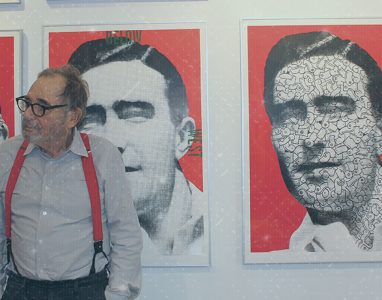Seymour Chwast has been a pioneering figure in the field of graphic design since the 1950s, continuously pushing boundaries and exploring new frontiers in design and typography. His influential work can be found in prestigious collections worldwide, including the Museum of Modern Art, Cooper Hewitt, The Library of Congress, The Gutenberg Museum, and The Israel Museum, among others.
Born in New York City in 1931, Chwast was immersed in a vibrant artistic environment from an early age, nurturing his passion for creativity. His formal artistic education began at Brooklyn’s Abraham Lincoln High School and later at Cooper Union, where he laid the foundation for his illustrious career.
After graduating in 1951, Chwast held various jobs, including working on promotional art for the New York Times and at Esquire magazine. In 1954, he co-founded Push Pin Studios with fellow Cooper Union alumni Edward Sorel and Milton Glaser, launching the bi-monthly publication The Push Pin Graphic in 1957.
In 1970, he met Paula Scher (a highly respected graphic designer in her own right) during an interview she had with him at Pushpin. They married in 1973. Although they divorced five years later, they remarried in 1989 and have since been considered a major power couple in the design field.
Chwast’s career is marked by a vast body of influential work across various mediums, including posters, magazine covers, and publicity art. His unique graphic design style blends social commentary with whimsical illustrations, often referred to as his “Roxy Style.” Chwast’s poster designs are highly recognizable for their bold compositions and thought-provoking messages.
One of Chwast’s most notable designs is the 1967 poster for the American Dental Association’s “End Bad Breath” campaign. It features an illustration of a green-skinned man dressed as Uncle Sam set against a sunburst background in blue and white with his mouth wide open. Inside his gaping mouth, tiny American aircraft are depicted bombing equally tiny Vietnamese houses. The text “End Bad Breath” is displayed underneath in the same shade of blue as the background pattern. The poster effectively communicates two wildly unrelated stances. One stance for correct oral hygiene and one against US involvement in the Vietnam War.
While primarily known for his graphic design and illustration work, Chwast has also ventured into graphic novels, notably his interpretation of Dante’s “Divine Comedy” published in 2010. In this adaptation, he distils the complex literary work into a visually compelling narrative using his signature bold and whimsical style.
Overall, Seymour Chwast’s impact and legacy on graphic design are characterized by his fearless experimentation, boundless creativity, and unwavering commitment to using design as a tool for social change. His contributions have helped shape the evolution of graphic design as a vibrant and dynamic discipline, leaving an indelible mark on the visual landscape of the 20th and 21st centuries.

